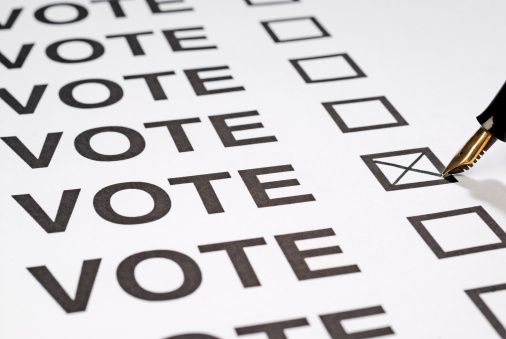Commentary: Thanks due to election workers, who keep the wheels of democracy turning
By Paul Rozycki
For those of us who spend our time trying to analyze the most recent election with polls, predictions and punditry, it’s easy to forget about all the work and preparation that goes into just running an election. The job of putting the ballot together, setting up the voting machinery, staffing the 231 precincts in Genesee County, and finally counting the votes in a timely and accurate manner, is no small task. That task rests with an army of election workers who are charged with setting up the voting equipment, guiding thousands of voters through the polls, gathering the votes for counting, and returning all the tables, chairs, voting machines, and booths at the end of a very long day.

Voting
While most of us see only a few elections workers at our own voting location, for only a brief time, the process of setting up and running an election is a challenging one, especially in these times of partisan division, and distrust of the election process. While passing out ballots and collecting them might seem routine, it’s more vital than ever to do it right.
There may have been a time when working an election was a simple process that could be done by anyone, with little training. Maybe that was true when Abe Lincoln ran for Congress in the 1840s, and all voters had to do was walk into the local log cabin, put an X on the paper ballot, and stuff it into a wooden box. But today’s elections are more complex than that, and today’s poll workers face challenges that go far beyond those in the past.
The challenges voting inspectors face
In Flint, there are 62 precincts that need to be staffed by hundreds of poll workers. Those workers are trained to do much more than stuff a paper ballot into a wooden box. With voting equipment always changing, they must be up to date on how to set up and use the latest computer technology. They must be able to set up and adapt that technology to a variety of temporary situations, as polls are set up in schools, churches, and community centers.
As with the technology, the laws and procedures that are part of the voting process are always changing, and workers need to be up to date on the latest changes. And those elections often take place while other activities are going on at voting locations, so election inspectors must work around the daily business of local churches, schools, and community centers.
This year’s election
Poll workers must also deal in a civil manner with voters who may be impatient, partisan or simply confused about the voting process. This year presented new challenges to voters and the poll workers behind the table. For the first time in 127 years, Michigan voters didn’t have the option of voting a straight ticket, where a single mark would cast a vote for all the members of a party. This year, voters had to vote individually on each and every office from governor to the local school board. In Flint, voters were expected to cast more than 28 separate votes on candidates and issues. The number was even higher in many areas of the county.
In addition, this year, there were three fairly complex state-wide proposals on the ballot, and if voters hadn’t studied them earlier, they could easily take a lot of time in the voting booth going over them. There were also more than a few new voters who were just learning the process. Workers also need to be ready to deal with voters who may be in the wrong location, have moved, or those who need to cast provisional ballots. All of that can lead to long lines, angry voters, and the election workers who face the brunt of that frustration.
Long hours at the polls
The hours are long. While the polls are open from 7 a.m. until 8 p.m. the workers’ day begins well before the polls open and ends long after they close. Typically, the set up for the election begins no later than 5:30 a.m. and poll workers must stay until the votes are collected and made ready for counting. At the end of the day, the workers are responsible for delivering the votes to the tabulation center, packing up the voting equipment and returning it. At a recent gathering of election workers, several told of staying until early the next morning, after the election, to deal with unexpected issues that arose.
The job is even more difficult because it’s normally only done three times a year. For most of us, when we do a job every day, we get used to a predicable routine that, hopefully, makes us better at what we do. There isn’t much time to build up a routine for most election inspectors.
Training for election workers
For the election workers, the preparation for Election Day begins weeks before the voters show up. After workers are hired, they are expected to attend a series of training sessions and workshops prior to the election. This year, depending on their duties, election workers were expected to attend an orientation workshop, a training session for all election workers, a workshop for those working with electronic poll books, and a special training session for an Absentee Voters’ Counting Board, and those involved with technical support. Supervisors also are expected to receive additional training. Workers are paid for the training sessions as well as their work on Election Day.
In spite of all the challenges of the job, at a recent gathering of this year’s election inspectors, many said it was rewarding to be a part of the most basic part of democracy—voting. They were reminded of how the right to vote has gradually been expanded over the last 200 years, to include more than just white, male, property owners. They learned of the many times that one vote has made a difference in past elections, and how one vote has changed history. They took pride in the fact that they are the first step in making sure those votes count.
Becoming an election inspector

Paul Rozycki
Those who work the polls must be registered voters and can’t be a candidate or member of a candidate’s family, a member of the local Board of Canvassers, or an election challenger. Those interested in being an election worker may submit an application to their local city or township clerk. While many election workers have been helping voters for a long time, and bring a wealth of experience with them, there is always a need for new workers to assist voters. Michigan’s 83 counties, 274 cities, and 1,242 townships, all need a staff of paid poll workers at election time. Websites for the City of Flint, Genesee County, and most local municipalities, offer more details on the process, and how those interested might apply.
It’s an important job on the front lines of democracy, and they deserve our thanks.
EVM political commentator Paul Rozycki can be reached at paul.rozycki@mcc.edu.


You must be logged in to post a comment.